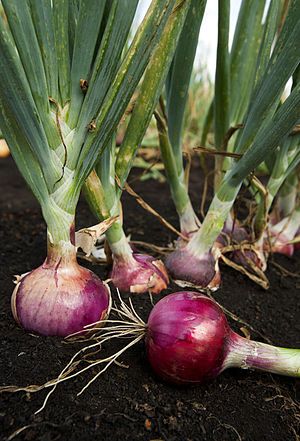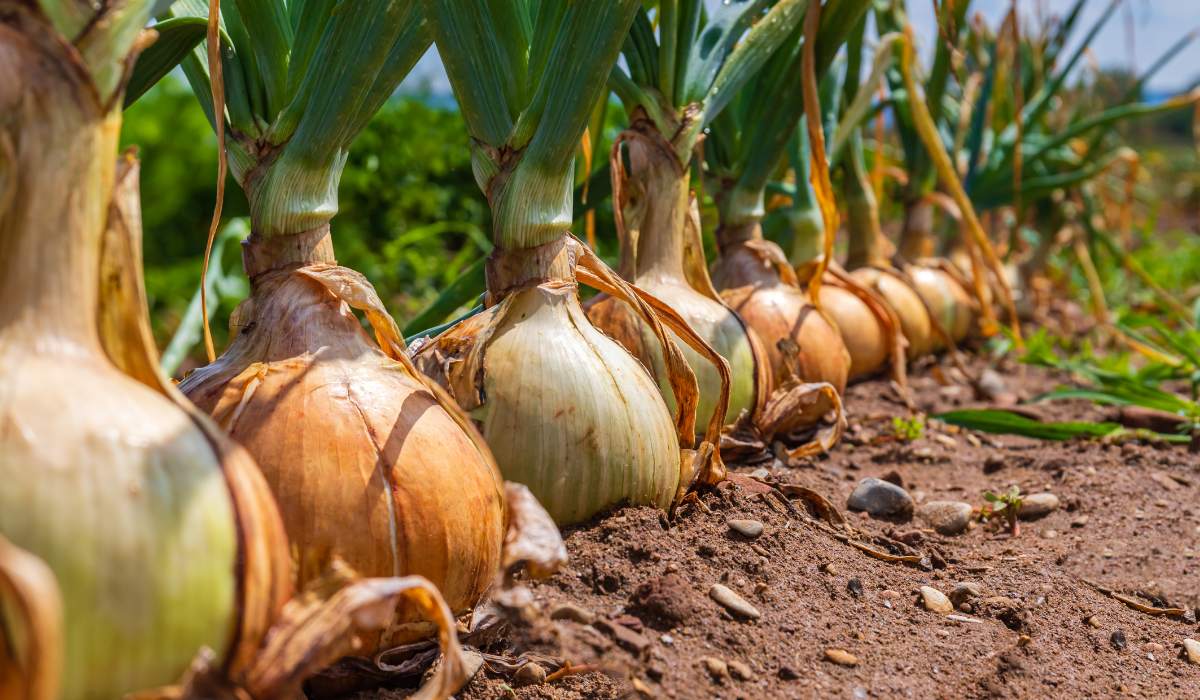Onions, with their distinct pungency and remarkable versatility, have earned their place as a cornerstone in the culinary world. Whether they’re sliced and added raw to refreshingly crisp salads, simmered to tender sweetness in rich gravies, or used to infuse depth and flavour into hearty soups and stews, onions are an indispensable ingredient found in kitchens across the globe. India, a country known for its rich agricultural heritage, proudly stands as the world’s second-largest producer of these flavorful bulbs.
In this article, we will take a look at how to grow onions, providing you with a comprehensive guide that encompasses all aspects, from climate and soil requirements to cultivation techniques and the optimal time for harvesting.
Which climate is suitable for onions?
Onions are versatile, growing in various climates, from temperate to tropical. They thrive in milder conditions without extreme cold or heat and prefer well-distributed rainfall, typically around 650-750 mm annually during the monsoon season. In India, the choice between short-day onions (requiring 10-12 hours of daylight) in the plains and long-day onions (needing 13-14 hours of daylight) in the hills depends on the region’s daylight hours. During their growth stages, onions appreciate temperatures between 13-24˚C for leaf development and 16-25˚C for bulb formation. Maintaining around 70% relative humidity supports their growth, but areas with too little or too much rainfall may not be ideal for rain-fed onion crops.
Which soil is best for onions?
Onions can grow in various types of soil, including sandy, clay, and loamy soils. But for the best results, they love deep, crumbly loam or alluvial soil that drains well, holds moisture, and has some organic matter. If you have heavy soil, adding organic fertiliser before planting can help. The soil should have a pH level between 6.0 and 7.5, but onions can also tolerate slightly alkaline soil. However, they don’t do well in highly acidic or salty soil or in areas with too much water. So, keeping your soil in this sweet spot will give you the best onion harvest.

Source: Pinterest (growsoeasyorganic.com)
Sowing method for onions
Let’s explore the various sowing methods available for successfully cultivating your own onions
Nursery raising
To create a good onion nursery, prepare raised beds by ploughing and removing debris, weeds, and stones. Mix in well-decomposed farmyard manure (FYM) during the last ploughing. Raised beds should be 10-15 cm high, 1.0 – 1.2 m wide, with 30 cm spacing. Use pendimethalin at 0.2% to control weeds. Sow about 5-7 kg of seeds per hectare, treated with thiram at 2 g/kg. After sowing, cover the seeds with compost and water lightly. Consider using drip or micro-sprinkler irrigation. For disease prevention, apply benomyl at 0.2%. Seedlings are ready for transplanting in 35-40 days for Kharif or 45-50 days for late Kharif and Rabi seasons.
Raising small bulblets
This method yields early green onions for salads. Use small onion bulblets from the previous Kharif season. Prepare beds, sow 15 g of seed per square metre from mid-January to early February, and leave the plants in the nursery bed until April-May. Harvest tops and select 1.5 to 2.00 cm diameter bulblets. Store them by hanging until July for Kharif season transplanting.
Broadcasting in beds/direct sowing:
In some areas, sow big onion seeds directly in rows with 30 cm spacing, thinning later for bulb growth. For small onions like Bangalore Rose, Agrifound Rose, and Arka Bindu, broadcast seeds in flat beds and thin them later. In the field, use 20-25 kg of seeds per hectare. In the plains, sow seeds with 30 cm spacing between rows during September-October. After sowing, hand hoeing ensures seeds are at the right depth (2.5-3 cm). Water immediately after sowing and weed every ten days to prevent weed competition.
How to plant onions?
Follow these steps to plant onions with confidence, ensuring a successful and abundant harvest of this versatile vegetable:
Land preparation
The first step in growing onions is to prepare the planting area. Begin by ploughing and thoroughly tilling the soil to remove any debris and break up clods. This creates a smooth and workable surface for planting. To make the soil rich and provide vital nutrients, incorporate organic manure into the soil. You can use well-rotted farmyard manure, poultry manure, or vermicompost. This is typically done during the final ploughing. Afterward, level the field to create a uniform surface. It’s important to note that during the rainy season or Kharif season, it’s advisable to avoid flat beds to prevent waterlogging, which can lead to diseases.
Bed formation
In this step, you’ll create the beds where you’ll plant your onion seedlings. The standard bed size is typically 1.5-2.0 metres wide and 4-6 metres long. However, for improved drainage and disease prevention, you may opt for a different approach known as broad bed furrows (BBF). BBF involves making beds that are 15 cm high with a 120 cm top width and 45 cm furrows. This method is suitable for both drip and sprinkler irrigation, allowing excess water to flow out through the furrows. It also enhances soil aeration and reduces the risk of diseases like Anthracnose.
Seedling selection
Carefully choose healthy onion seedlings for transplanting. Avoid using seedlings that are either too old or too young. Healthy seedlings are more likely to establish themselves well and lead to a successful crop.
Trimming seedlings
Before transplanting the seedlings, it’s a good practice to trim about one-third of the top part of each seedling. This helps the seedlings focus their energy on root development and ensures better establishment in the soil.
Transplanting
Once your bed rows are ready and you have selected and trimmed your seedlings, it’s time to transplant them. Dip the roots of each onion seedling into a solution of carbendazim (0.1%) for about two hours. This helps decrease the risk of fungal diseases during the early stages of growth. When transplanting, place the seedlings with a spacing of 15 cm between rows and 10 cm between individual plants. This spacing provides enough room for the onions to grow without overcrowding each other.

Source: Pinterest (Houseplant Central)
How to water onions?
Watering onions is important, and how much they need depends on the season, soil, and age. Generally, onions like a bit of water when they’re planted, then about three days after, and later on, every 7-10 days, depending on how wet the soil is. For example, Kharif onions need 5-8 rounds of watering, late Kharif needs 10-12, and Rabi needs 12-15. Since onions have shallow roots, it’s best to give them a little water often to keep the soil just right for growing and making bulbs. But when they’re almost ready for harvest, and the tops start falling over (about 10-15 days before picking), stop watering to prevent rot during storage. Avoid giving them too much water, or it can make the outer layers split and even cause some to flower. Also, be mindful that flood irrigation can waste a lot of water because it seeps away or soaks in.
How to harvest and store onions?
To harvest and store onions, watch for signs like yellowing and falling tops. For dry onions, it takes about five months, and for green onions, three months. Harvest when tops start falling, usually when half have fallen. In the rainy season, harvest when leaves change colour. Dry bulbs are picked gradually after tops fall. You can pull them by hand in sandy soil or loosen them with a tool. Let them dry in rows in the field, then trim leaves, leaving 2-2.5 cm on top. Store onions in a well-ventilated, sunny spot. Use bags with holes, stack them not too high, and leave space for air.
FAQs
When is the best time to cultivate onions in India?
In India, onions can be planted during three seasons: Kharif (sown from July to August and harvested from October to December), late Kharif (planted between October and November, with harvesting occurring from January to March), and Rabi (sown in December to January, and harvested from March to May).
Are onions suitable for beginners in gardening?
Onions are often considered a bit challenging to grow, but most gardeners can master it with some practice. It's a good idea for beginners to start with onion sets, as they tend to have a higher success rate.
How long does it typically take for onions to grow to maturity?
Generally, it takes around three to four months for onions to reach maturity, although the exact time can vary based on the onion variety and the planting method used.
Do onions regrow each year on their own?
Onions are biennial plants, meaning they complete their life cycle over two growing seasons. However, for practical purposes, most gardeners treat them as annuals and harvest the bulbs before they plant flowers and produce seeds.
What are the ideal soil conditions for growing onions?
Onions can thrive in various soil types, but the best soil for successful cultivation is deep, friable loam with good drainage, moisture retention, and organic matter content.
Can onions tolerate extreme weather conditions?
Onions can withstand a range of climates, but they perform best in mild weather without extreme cold or heat. They require different day lengths for vegetative growth and bulb development.
How often should I water my onion plants?
Onion irrigation depends on factors like season, soil type, and crop age. Generally, onions need regular but not excessive watering, with a pause as they approach maturity to prevent rot.
What are the key pests and diseases that affect onion crops?
Common pests and diseases for onions include thrips, aphids, and fungal issues like damping off and Anthracnose. Proper management strategies are essential to control these problems.
When is the best time to harvest onions for different purposes?
The timing of onion harvest varies depending on the intended use. For green onions, you can harvest them as soon as three months after transplanting. Dry onions are typically ready for harvest in about five months.
How should I store onions to keep them fresh for an extended period?
To store onions effectively, keep them in a well-ventilated place with plenty of air and sunlight. Use perforated bags, stack them vertically but not too high, and ensure there's space for air circulation to prevent spoilage.
| Got any questions or point of view on our article? We would love to hear from you. Write to our Editor-in-Chief Jhumur Ghosh at Jhumur Ghosh |






